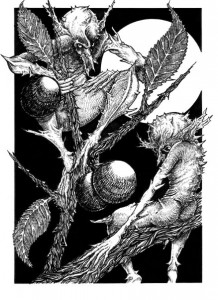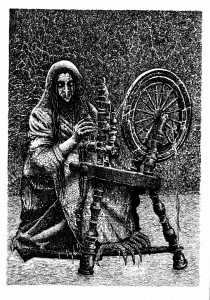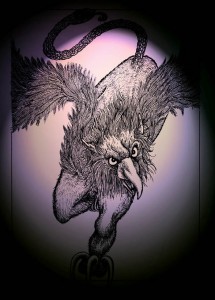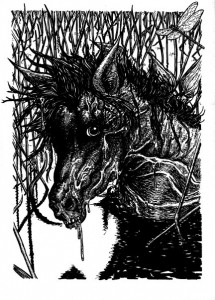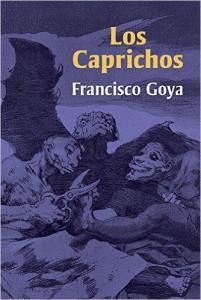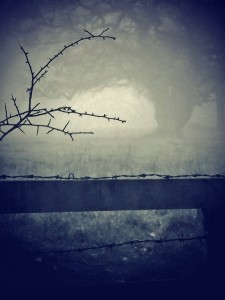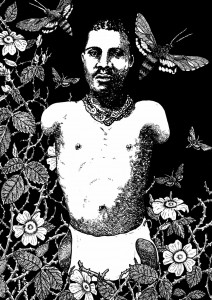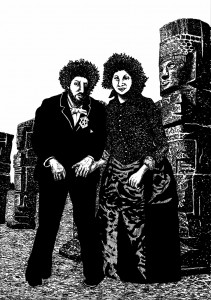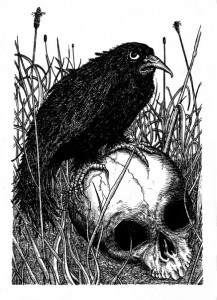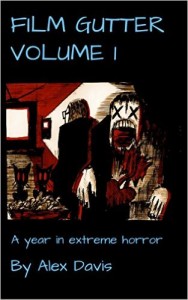We are great enthusiasts of weird, surreal and magical art here, as all our loyal listeners know. We have no disloyal listeners, as they were given a free tour of Mrs Gumworthy’s Meat Pie Factory, and unaccountably disappeared around that time.
So it’s our great pleasure to welcome German surreal artist Michael Hutter to the site, especially as his range of stunning illustrations includes the Carcosa cycle, a theme which crosses into so many works of strange fiction.
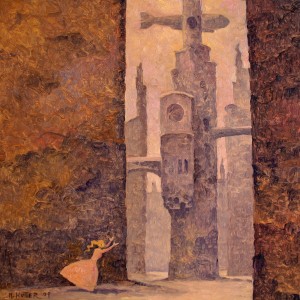
Before we interview him, we should say a little about Carcosa itself, Pre-eminent among the authors who have written of this haunted city are the Father of Carcosa, Ambrose Bierce (1842-1913?), the Master of the Yellow Sign Robert W Chambers (1865- 1933), and of course H P Lovecraft and his inheritors.
(The question-mark by Bierce’s date of death is due to his disappearance, with a last supposed letter dated December 1913. There is still no satisfactory explanation of when – or indeed where – Bierce died.)
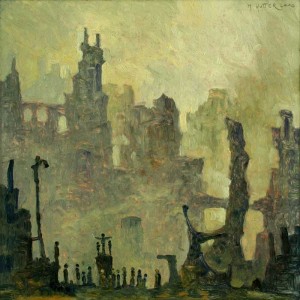
If there is a beginning to our trail today, then it lies in An Inhabitant of Carcosa. This story by Bierce was first published in the San Francisco Newsletter in 1886, and then included as part of his collection Can Such Things Be in1887. It’s a short piece, and appears at first to be about a man who awakens from sickness to find himself in an unfamiliar landscape. You’ll have to read the story to grasp what else might be implied. It can be found online – one link which usually work is here:
Alternatively you can listen to an audio version:
The narrator in the above version is Otis Jiry.
Robert W Chambers built on An Inhabitant in his stories of the Yellow Sign, collectively known as The King in Yellow. He used and re-interpreted some of Bierce’s names, and his stories refer to a play, similarly called The King in Yellow, which says more about Carcosa itself.
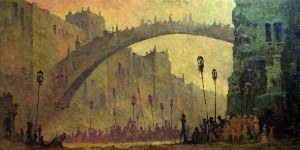
Reading this forbidden play brings new insights into the universe, as well as despair or utter madness. People have said the same of greydogtales, mind you.
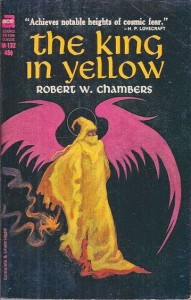
Where Bierce placed the city of Carcosa in the apparent past, in Chambers it is to be found on the shores of Lake Hali in the Hyades, either far from our own planet or in a dimension/universe apart from ours.
Along the shore the cloud waves break,
The twin suns sink behind the lake,
The shadows lengthen
In Carcosa.
Strange is the night where black stars rise,
And strange moons circle through the skies,
But stranger still is
Lost Carcosa.
Songs that the Hyades shall sing,
Where flap the tatters of the King,
Must die unheard in
Dim Carcosa.
Song of my soul, my voice is dead,
Die thou, unsung, as tears unshed
Shall dry and die in
Lost Carcosa.
—“Cassilda’s Song” in The King in Yellow Act 1, Scene 2
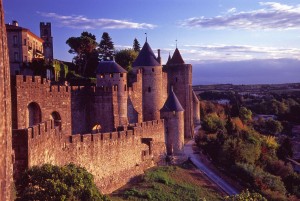
Some think that Bierce was drawing on an imaginative view of the French medieval city of Carcassonne, which was called in Latin Carcaso. Sadly, although we’ve been to Narbonne, and slept in a public park in Perpignan (the gendarmerie were not amused), we’ve never been to the great walled city itself.

There have even been suggestions that Bierce knew of a song/poem by Gustav Nadaud (1820 – 1893), Carcassonne. This seems questionable, as the nearest date we’ve found so far for Nadaud’s piece is 1887, the year after An Inhabitant was published. However, it is possible that the work was in circulation before that. Carcassonne the poem is about a man who will never see that ‘fabled’ city, and is quite interesting in itself in that it evokes a sense of how strange and wonderful the city is.
‘They tell me every day is there
Not more or less than Sunday gay:
In shining robes and garments fair
The people walk upon their way.
One gazes there on castle walls
As grand as those of Babylon,
A bishop and two generals!
I do not know fair Carcassonne,
I do not know fair Carcassonne!’
Check out the full poem by Nadaud if you like to pursue these threads – it’s easily found online.
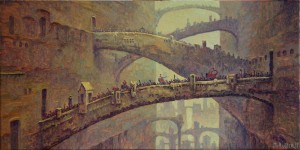
Many gifted contemporary writers have continued exploring Carcosa and related concepts, but there are too many to mention here. Joe Pulver Sr alone has contributed numerous stories and poems to this area, and there have been some excellent anthologies in recent years. We might try and pick up on a few if we do a dedicated King in Yellow post at some point.
####
And so to our guest Michael Hutter. Despite telling us that he doesn’t talk well about himself or his work (and the fact that our German is very rusty), he was still kind enough to participate in an interview for greydogtales – and to send us loads of artwork to accompany the interview. We feel somewhat honoured that he was willing to take the time, and have tried to illustrate the post with as many of his works as we could.
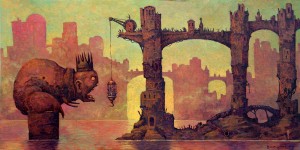
Michael Hutter is a German painter, illustrator and author who studied at the University of Applied Sciences in Koln under Professor Marx, a painter himself who produced a number of challenging expressionist works. Michael has had many solo exhibitions in the last thirty years, in addition to providing illustrations for fantasy books, heavy metal albums and other media, and once said of his paintings:
“In my opinion truth is somehow an illusion anyway. I mix that with my obsession, passions, desires and fears and choke what happens in the abyss of my personality back on the surface.”
Let’s get down to our interview.
greydog: Michael, thank you so much for joining us. We, and many of our visitors, are enormous fans of your art. Do you have a central vision for your work, a set of principles, or is it a more unconscious process?
michael: I try to follow the logic of dreams, it’s an unconscious process.
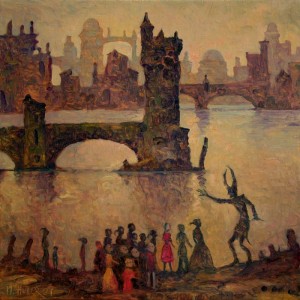
greydog: Much of your art is presented as a number of themes – Inkubi, Carcosa, Games in Purgatory und so weiter. Do you work intensively on a particular theme or concept for some time, or do you collect together pieces with common aspects later on?
michael: One idea or “story” usually has several aspects. I try to find them all and tell it to an end. This is how the work-groups develop. Sometimes I realise during working on it, that it is a series, on other occasions I know it from the beginning. Sometimes I start with the idea of a story and develop the pictures from there, sometimes it is the other way round: I start with one (or a few) picture ideas and realise during painting or drawing that there is a connection, sometimes a story, sometimes just a feeling. You see, it’s a bit complicated…

greydog: We’re not experts, but we see obvious echoes of Hieronymus Bosch, the Surrealists, Tarot art and even non-European elements. Are there particular artists from the past who you feel influence you?
michael: I think influence is overrated. We are all standing on the shoulders of giants. And those giants have been influenced themselves by others who have been before them and so on. Of course Bosch is important to me, but so are many others. If I want to do justice to all, the list would grow much too long (and quite boring as well). The interesting thing about an artist is not where he is coming from, but what he or she might add to the evolution of art.
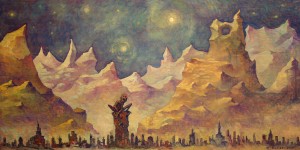
greydog: Yes, a fair point. Your work is described variously as surreal, magical and visionary. Do you feel part of the Visionary Art movement, as promoted by Laurence Caruana?
michael: I feel part of the evolution of art, but not to any smaller group or sect.
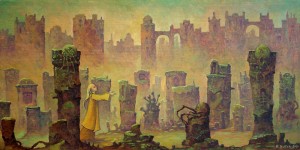
greydog: A number of artists (and aspiring artists) read greydogtales. Could you tell us something about the main techniques you use?
michael: I prefer traditional techniques like oil, tempera or watercolour. I do my ink drawings with a dipping pen and my graphic works are mostly etchings.
Most of my oil paintings are done in a very precise three layer technique, the “Carcosa” cycle is an exception: the pictures are painted in one layer – fast and quite “impressionistic”.
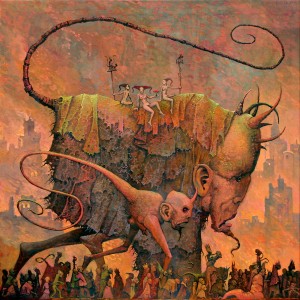
greydog: We’re not very familiar with contemporary German art. Is there much interest in your work in your home country, or do you look more to the international scene?
michael: I’m not very familiar with contemporary German art either. It seems that the official art scene is quite hostile against fantastic art in my country. I’m much more interested in the international scene, and thanks to the web I have good opportunities to show my works in all parts of the world that have free access to the internet.

greydog: This is the first time we’ve seen your photographic work. The Ancestors Gallery and Inkubi and Sukkubi present disturbing and distorted views of humanity. Is this a period from your past, or do you still produce these kind of pieces?
michael: Hmm, it’s rather a period from the past. I really like these photoshop works, they were very inspiring to me and had a big influence on my painting and drawing, but in the end I really prefer the unique character of traditional works. And I prefer the haptic surface, the brushstrokes or the feeling of fine lines that you can feel with your fingertips to what comes out of an inkjet printer.
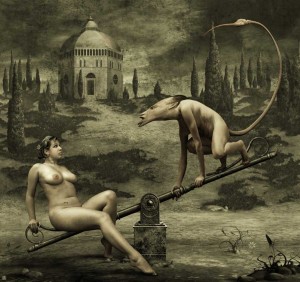
greydog: We are also great admirers of Santiago Caruso from Argentina, whose pictures share certain aspects of surrealism with some of your own. Are you familiar with him?
michael: I saw some of his works on the internet and liked them a lot.

greydog: Your Carcosa illustrations are absolutely superb. We know many enthusiasts of writers like Robert W Chambers and Ambrose Bierce – do you read much early and weird fiction yourself?
michael: No doubt, weird fiction has a big influence on my work, I have always read a lot. I think I was about sixteen when I discovered Lovecraft and Clark Ashton Smith and it hit me like an epiphany. Literature (specially if it deals with the strange and uncommon) still has a very big influence on me.
Again my “list of influences” would be too long and boring for this short interview. But to mention a few – of course the classic writers like Poe, Lovecraft, Chambers, Smith and so on. Very important is the Bible (maybe the cruellest book I have ever read), the fairy tales of the Grimms, Mervyn Peake’s “Gormenghast”, also I’m a great admirer of Thomas Ligotti… and now I’m so unjust to stop this list.
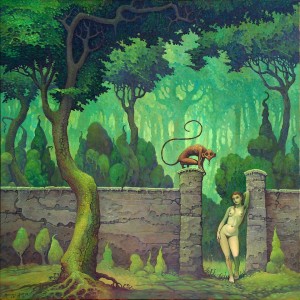
greydog: And finally, do you have a major direction or project for the year to come?
michael: Doing the paintings, especially the altarpiece for a huge cathedral, sculpting a city of eerie doll-houses, transforming the Book of Genesis into a Lovecraftian graphic novel… there are lots of ideas but the trouble is, that life is not long enough to do everything that I’d like to do…
Currently I’m finishing a project that occupied me for over two years: “The Kranzedan” a cycle of (very) short stories, drawings and oil paintings. I’m trying to put this material together as a book, still not knowing how and where to publish it.

greydog: Many thanks for joining us – we look forward to your new works, and we hope that The Kranzedan will emerge soon.
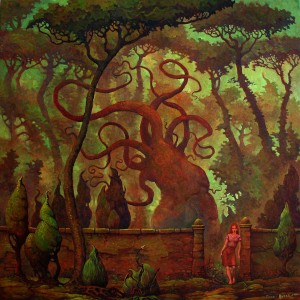
Another of Michael’s earlier projects was Melchior Grun, five ballads told and drawn by him, tales of a wandering medieval minstrel, Melchior Viridis. With baroque illustrations to accompany the text, Melchior travels areas, “which had never before seen a Christian”, and is confronted with the sins of the flesh and malicious contemporaries. This was a limited edition which is no longer available as far as we know.
[UPDATE: Michael has just informed us that some copies of Melchior are still available directly from him. Contact him via his website, given later below.]
You can obtain copies of the following, but only as a German language e-book. Die Dämonenbraut (The Demon Bride) is written as a fragment of the memoirs of Richard Upton Pickman. H P Lovecraft fans will recognise the name from Lovecraft’s 1926 story Pickman’s Model about an artist who creates horrifying images and is banned from his Boston circles.
And Michael Hutter’s website is at:
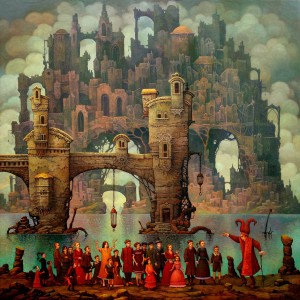
Thank you as well, dear listeners, for joining us. In the next week or so, we really mean to get that Torchwood and Zelazny post together, and we have a great interview with occult detective author, Warhammer scribe and writing-machine, Joshua M Reynolds!

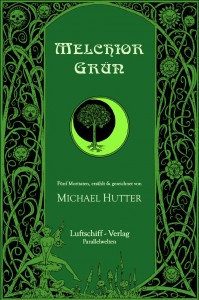
 Die Damonenbraut at Amazon UK
Die Damonenbraut at Amazon UK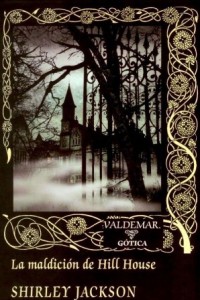
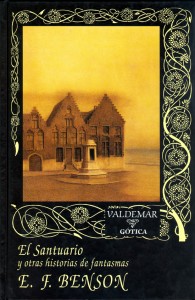
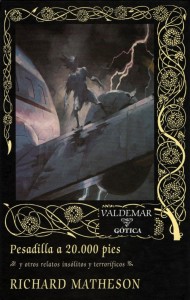
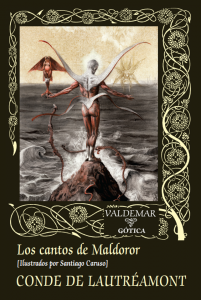


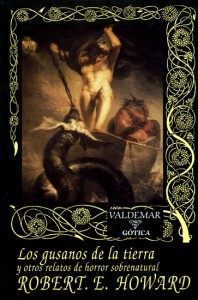
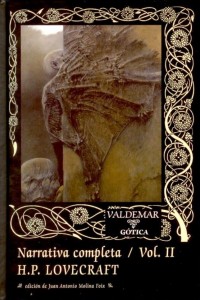

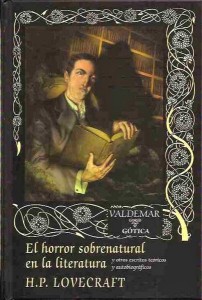
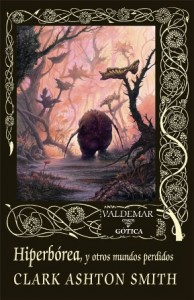
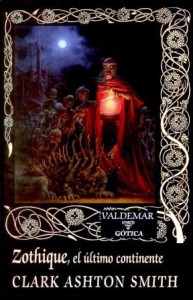
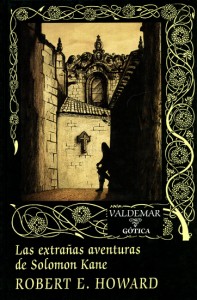
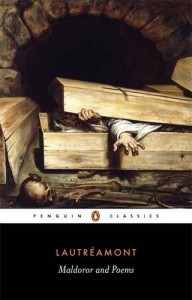 the songs of maldoror
the songs of maldoror


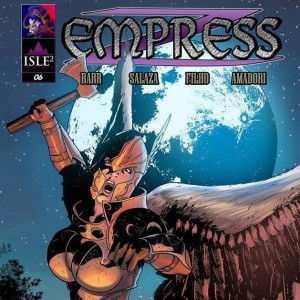
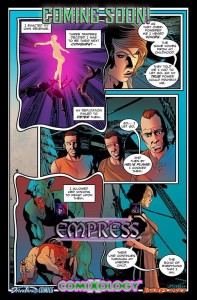
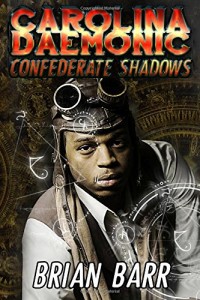
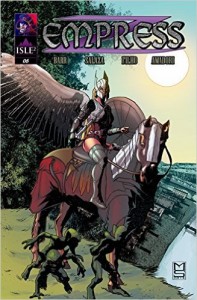 empress at amazon
empress at amazon

